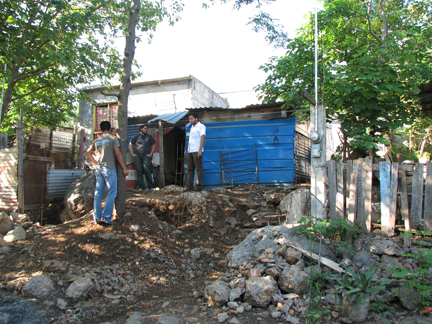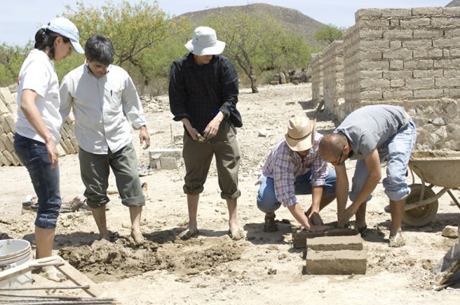Jesse Miller

Outside “Casa Rosenda” Monterrey, Mexico
The Architectural Masters Thesis. High expectations and the culmination of one’s educational career are commonly used to describe this thing that looms as the end of graduate school approaches. It is a thing that has much implied importance and historical baggage. Though all these factors that initially seem overwhelming appear to be set in rigid guidelines and requirements, opportunities arise to break away and take control of one’s own thesis.
Upon completing five years of architectural education, which included three internships and a year in graduate school, I had become critical of how I was being educated. The educational system is defined by the profession—a profession that serves a small minority of the people in the world, that is often ignorant of the realities within local communities, arguing with itself about its credibility, a profession made up of thousands of office workers not doing what they imagined they’d be doing all those years ago in their respective schools. In this model, the normal route for a thesis is to make up a project that embodies the skills one has learned and adhere to a sort of design manifesto, resulting in a paper project. This was not something I wanted. Upon realizing and defining my discontent, the semester before thesis I elected to join a studio that designed while questioning normality and looking at new sources of inspiration. Furthermore, I began participating in simple and complex things outside of architecture around the campus and community: a visit to Skid Row in L.A.; a visit to the Mexican border including a safe haven for deportees; meeting with a friend working with homeless high school students; becoming very active in a campus environmentalist group; working with a team to assess the local YWCA and offer suggestions. All of these activities were about looking at more than what I had become comfortable with in school. A normal route for thesis was no longer an option, so I chose to leave the country. Learning From and Working With Ignored Communities became the title for my thesis proposal, which consisted of moving to Monterrey, Mexico, attending Instituto Tecnológico y de Estudios Superiores de Monterrey (ITESM), and participating in projects that addressed social problems at the community and personal level. My thesis set out to address the above summarization of my thoughts and be an experience rather than a defined project— to be a learning experience for the future and not a summary of my past. Of course the semester was good. Of course I was impressed by what I learned, saw, experienced, and by the people I met. I could write about the work I did and tell about the processes that went on, but I believe a brief discussion of some ideas, realizations, and questions that have arisen from this experience is more apposite. A thorough summary of the thesis semester can be found at: http://themonterreyexperience.blogspot.com.
One of the first major revelations I recall having came about while participating in the 10 Casas para 10 Familias program, or 10X10 for short. 10X10 is a program that improves housing of employees of ITESM who currently live in unsound, crowded, and/or undesirable conditions. The program is mainly student run and coordinated as each student of ITESM must complete about 400 hours of social service before graduation. The project I was most familiar with was Casa Rosenda which was located in a neighborhood which began as a grouping of illegal shelters on the lower slopes of Cerro de la Silla, the mountain which is Monterrey’s landmark.
Rosenda currently lives in a house made up of pieces of blue metal sheeting attached to a structure of wooden boards. A small separate concrete room is unusable because sewage from the neighbors seeps into it. The new building, which has the foundation already poured, will be made up of a steel frame with large pieces of fiberglass, which were previously used as framework for pouring a parking garage, as the walls. Though working and learning from this project was exciting and though it felt good, it did not seem like an overall solution. The neighborhood contained many problems that were not addressed by the project. The roads were difficult to drive over and many cars could not survive the rocky paths. Pirated power was evident, unsanitary drainage could be seen, and drugs were offered for sale out in the wide open. I also heard stories of gang-related crime within the neighborhood, specifically a large fight the night before one of the visits, and robberies happening in neighboring areas. I realized that the stories architects and designers tell about the positive impacts their simple projects will have on the surrounding neighborhood often are little more than talk. In this case, realistically speaking, Rosenda and her grand-daughter are going to be the only ones truly affected by this project.
It is true that someone outside of the “2% that are served by architects” is being attended to, but the project is still being funded by that 2%, in this case by the university. I had begun thinking that to really be effective in terms of social issues, architects and designers must be more than architects and designers, must play more than the traditional role, and this was the first clear-cut example I came across. Another realization I had explains why architects and designers are hesitant or hindered when it comes to moving beyond their traditional roles. The studio project that I participated in was a redevelopment of a low-income neighborhood. In the metropolitan area of Monterrey, there are large housing developments often consisting of nearly identical small living units. These housing areas are built based on cost and efficiency while human comfort and environmental concerns are barely addressed.
The neighborhood where our project is situated (it is a multi-studio project that is intended to be implemented in the future) is in an area that was initially created for people who could not afford the mass produced homes. Many of them were moved from areas around the metropolitan area where they had settled illegally. After a lengthy research phase, the areas of transportation, environmental quality, infrastructure, water management, housing, public amenities, and recreation are being addressed. While this is a good project for a design studio, it is difficult to make it into a reality in the metropolitan area of Monterrey. The first hurdle is the fact that within a short number of years there is a very good possibility that nearly every position in every level of government will change, due to the way the election process is set up. These changes could result in people with similar goals and education as the current officials, or could result in people antithetical to the present project. Because of this fact, a strategy for continuation of the project, despite possible changes in local government, has to be implemented.
A department of the university has agreed to help out with this part of the planning, but this also means that there is even more feedback on an already very complex project. To add to the complexity, government positions are often overly politicized, so the project had to be free of anything that could be canceled because of politics. My semester on this project was the first semester, so we did not have to delve very deeply into these issues. However, it became apparent why an architect or planner would not want to get involved in such a process. And it goes to show why so many horrible housing developments have been created without much of a change.

Students mixing adobe bricks
One of the best realizations came a few weeks after the official semester ended. At that time, which was also the end of my graduate career, I was not ready to leave Mexico. I was given an opportunity to remain in Monterrey for an additional month to continue work on another project. The project was based in a small desert village (about 80 people) named San Felipe. Traditional building methods are not commonly used anymore due to depleted sources of wood and vegetation and the ease of construction with mass-produced products. Unfortunately, the mass-produced materials have higher costs and are more harmful to the environment. The challenge was to design and build a prototype home that mixed traditional methods with mass produced materials where they were needed. After a semester of visits to the village; sketches and photographs of area buildings; and brief conversations with the people, summer arrived which meant time to focus exclusively on the prototype house.
One day, after several weeks of work, I suddenly realized that I knew how everything was going to go together in the house. Granted it is a small building, but never before in my six years of education, including three internships, had I ever felt this confident about the details of something I was working on. Spending a lot of time becoming familiar with the traditional materials, including making some adobe blocks, and being able to spend several weeks finalizing the design are things that are not common in architectural education. Therefore the student often does not get to fully understand his or her design. A semester that I had hoped would be more than a paper design project was indeed more than that. I gained understanding of and insight into topics I was intensely interested in and had had many questions about. I wanted a semester that would be much more than something for my design portfolio. I wanted a semester that would move beyond the desire to want to do something about the evident problems in the world, that it seems architecture is not doing enough to address. I wanted a semester that would not end, but lead to a career of similar work. The semester and inclusive projects were not perfect, but these goals were addressed and more was accomplished than I could have hoped for by remaining at home in Muncie.
For more information on the projects mentioned here, you can visit: http://www.mty.itesm.mx/dia/dia/ap_aguavida.htm for a summary of all the projects taking place in San Felipe.
Jesse Miller recently completed his M. Arch at Ball State University in Muncie, Indiana.











May 15, 2010 at 6:26 pm
Having enough trouble creating content for myself, but thanks for the compliment!
David Stairs